A Stochastic Model Based on Optimal Satellite Subset Selection Strategy for Smartphone Pseudorange Relative Positioning
Abstract
:1. Introduction
2. Positioning Model and Residual Analysis
2.1. Observation Model
2.2. Double-Difference Pseudorange Residual Analysis
3. DDPR-Dependent Model Based on Optimal Satellite Subset
4. Results and Discussion
4.1. Open Environment
4.2. Occluded Environment
5. Conclusions
- The DDPR effectively reflects the quality of observations. While the correlation between the DDPR and satellite elevation is not significant, it exhibits a strong correlation with the integrated C/N0.
- In occluded environments, a satellite subset boasting superior observational quality can be selected using the integrated C/N0. The positioning accuracy, when relying on this optimal satellite subset, markedly surpasses that derived from the entire constellation.
- In open settings, the merits of a DDPR-dependent stochastic model in pseudorange relative positioning are not markedly superior to the C/N0-dependent stochastic model. The experimental results from both smartphones indicate comparable positioning accuracy between the two models. However, in an occluded setting, the former model proficiently diminishes the weight of inferior-quality observations. This leads to enhanced positioning accuracy for both smartphones. Specifically, the Huawei Mate40 exhibited improvements of 30%, 32%, and 34% in the N, E, and U directions, respectively. The Huawei P40 also showcased enhancements of 26%, 33%, and 24% in the same respective directions.
Author Contributions
Funding
Institutional Review Board Statement
Informed Consent Statement
Data Availability Statement
Conflicts of Interest
References
- Psychas, D.; Bruno, J.; Massarweh, L.; Darugna, F. Towards Sub-Meter Positioning Using Android Raw GNSS Measurements. In Proceedings of the 32nd International Technical Meeting of the Satellite Division of The Institute of Navigation (ION GNSS+ 2019), Miami, FL, USA, 16–20 September 2019; pp. 3917–3931. [Google Scholar]
- Wu, Q.; Sun, M.; Zhou, C.; Zhang, P. Precise Point Positioning Using Dual-Frequency GNSS Observations on Smartphone. Sensors 2019, 19, 2189. [Google Scholar] [CrossRef] [PubMed]
- Zhang, X.; Tao, X.; Zhu, F.; Shi, X.; Wang, F. Quality Assessment of GNSS Observations from an Android N Smartphone and Positioning Performance Analysis Using Time-Differenced Filtering Approach. GPS Solut. 2018, 22, 70. [Google Scholar] [CrossRef]
- Wang, L.; Li, Z.; Wang, N.; Wang, Z. Real-Time GNSS Precise Point Positioning for Low-Cost Smart Devices. GPS Solut. 2021, 25, 69. [Google Scholar] [CrossRef]
- Li, Z.; Wang, L.; Wang, N.; Li, R.; Liu, A. Real-Time GNSS Precise Point Positioning with Smartphones for Vehicle Navigation. Satell. Navig. 2022, 3, 19. [Google Scholar] [CrossRef]
- Odolinski, R.; Teunissen, P.J.G. An Assessment of Smartphone and Low-Cost Multi-GNSS Single-Frequency RTK Positioning for Low, Medium and High Ionospheric Disturbance Periods. J. Geod. 2019, 93, 701–722. [Google Scholar] [CrossRef]
- Odolinski, R.; Teunissen, P.J.G. Low-Cost, 4-System, Precise GNSS Positioning: A GPS, Galileo, BDS and QZSS Ionosphere-Weighted RTK Analysis. Meas. Sci. Technol. 2017, 28, 125801. [Google Scholar] [CrossRef]
- Wanninger, L.; Heßelbarth, A. GNSS Code and Carrier Phase Observations of a Huawei P30 Smartphone: Quality Assessment and Centimeter-Accurate Positioning. GPS Solut. 2020, 24, 64. [Google Scholar] [CrossRef]
- Jiang, Y.; Gao, Y.; Ding, W.; Liu, F.; Gao, Y. An Improved Ambiguity Resolution Algorithm for Smartphone RTK Positioning. Sensors 2023, 23, 5292. [Google Scholar] [CrossRef] [PubMed]
- Fortunato, M.; Critchley-Marrows, J.; Siutkowska, M.; Ivanovici, M.L.; Benedetti, E.; Roberts, W. Enabling High Accuracy Dynamic Applications in Urban Environments Using PPP and RTK on Android Multi-Frequency and Multi-GNSS Smartphones. In Proceedings of the 2019 European Navigation Conference (ENC), Warsaw, Poland, 9–12 April 2019; pp. 1–9. [Google Scholar]
- Gao, C.; Chen, B.; Liu, Y. Android Smartphone GNSS High-Precision Real-Time Dynamic Positioning. Acta Geod. Cartogr. Sin. 2021, 50, 18–26. [Google Scholar]
- Tao, X.; Liu, W.; Wang, Y.; Li, L.; Zhu, F.; Zhang, X. Smartphone RTK Positioning with Multi-Frequency and Multi-Constellation Raw Observations: GPS L1/L5, Galileo E1/E5a, BDS B1I/B1C/B2a. J. Geod. 2023, 97, 43. [Google Scholar] [CrossRef]
- Paziewski, J. Recent Advances and Perspectives for Positioning and Applications with Smartphone GNSS Observations. Meas. Sci. Technol. 2020, 31, 091001. [Google Scholar] [CrossRef]
- Jin, X.X.; de Jong, C.D. Relationship Between Satellite Elevation and Precision of GPS Code Observations. J. Navig. 1996, 49, 253–265. [Google Scholar]
- Gao, C.; Zhao, Y.; Wan, D. The Weight Determination of the Double Difference Observation in GPS Carrier Phase Positioning. Sci. Surv. Mapp. 2005, 30, 28–32. [Google Scholar]
- Gpsworld.June97.Pdf. Available online: http://131.202.94.44/papers.pdf/gpsworld.june97.pdf (accessed on 11 March 2024).
- Brunner, F.K.; Hartinger, H.; Troyer, L. GPS Signal Diffraction Modelling: The Stochastic SIGMA- δ Model. J. Geod. 1999, 73, 259–267. [Google Scholar] [CrossRef]
- He, H.; Yang, Y. Real-Time Estimation of a Prior Variance-Covariance for GPS Observations. Acta Geod. Et Cartogr. Sin. 2001, 30, 42–47. [Google Scholar]
- Satirapod, C.; Luansang, M. Comparing Stochastic Models Used in GPS Precise Point Positioning Technique. Surv. Rev. 2008, 40, 188–194. [Google Scholar] [CrossRef]
- Wang, J.; Gopaul, N.; Scherzinger, B. Simplified Algorithms of Variance Component Estimation for Static and Kinematic GPS Single Point Positioning. J. Glob. Position. Syst. 2009, 8, 43–52. [Google Scholar] [CrossRef]
- Yu, X.; Gao, J. Kinematic Precise Point Positioning Using Multi-Constellation Global Navigation Satellite System (GNSS) Observations. ISPRS Int. J. Geo-Inf. 2017, 6, 6. [Google Scholar] [CrossRef]
- Zhang, X.; Li, P.; Tu, R.; Lu, X.; Ge, M.; Schuh, H. Automatic Calibration of Process Noise Matrix and Measurement Noise Covariance for Multi-GNSS Precise Point Positioning. Mathematics 2020, 8, 502. [Google Scholar] [CrossRef]
- Prochniewicz, D.; Wezka, K.; Kozuchowska, J. Empirical Stochastic Model of Multi-GNSS Measurements. Sensors 2021, 21, 4566. [Google Scholar] [CrossRef] [PubMed]
- Paziewski, J.; Sieradzki, R.; Baryla, R. Signal Characterization and Assessment of Code GNSS Positioning with Low-Power Consumption Smartphones. GPS Solut. 2019, 23, 98. [Google Scholar] [CrossRef]
- Li, Y.; Zhang, Z.; He, X.; Yuan, H.; Zang, N. An Elevation Stochastic Model Constrained by C/N0 for GNSS Real-Time Kinematic Positioning in Harsh Environments. Meas. Sci. Technol. 2022, 34, 015011. [Google Scholar] [CrossRef]
- Gao, R.; Xu, L.; Zhang, B.; Liu, T. Raw GNSS Observations from Android Smartphones: Characteristics and Short-Baseline RTK Positioning Performance. Meas. Sci. Technol. 2021, 32, 084012. [Google Scholar] [CrossRef]
- Zhang, Z.; Yuan, H.; Li, B.; He, X.; Gao, S. Feasibility of Easy-to-Implement Methods to Analyze Systematic Errors of Multipath, Differential Code Bias, and Inter-System Bias for Low-Cost Receivers. GPS Solut. 2021, 25, 116. [Google Scholar] [CrossRef]
- Yuan, H.; Zhang, Z.; He, X.; Li, G.; Wang, S. Stochastic Model Assessment of Low-Cost Devices Considering the Impacts of Multipath Effects and Atmospheric Delays. Measurement 2022, 188, 110619. [Google Scholar] [CrossRef]
- Sui, M.; Gong, C.; Shen, F. An Optimized Stochastic Model for Smartphone GNSS Positioning. Front. Earth Sci. 2022, 10, 1018420. [Google Scholar] [CrossRef]
- Zhang, Z.; Li, B.; Shen, Y.; Gao, Y.; Wang, M. Site-Specific Unmodeled Error Mitigation for GNSS Positioning in Urban Environments Using a Real-Time Adaptive Weighting Model. Remote Sens. 2018, 10, 1157. [Google Scholar] [CrossRef]
- Zhang, Z.; Li, B.; Gao, Y.; Shen, Y. Real-Time Carrier Phase Multipath Detection Based on Dual-Frequency C/N0 Data. GPS Solut. 2019, 23, 7. [Google Scholar] [CrossRef]
- Liu, W.; Shi, X.; Zhu, F.; Tao, X.; Wang, F. Quality Analysis of Multi-GNSS Raw Observations and a Velocity-Aided Positioning Approach Based on Smartphones. Adv. Space Res. 2019, 63, 2358–2377. [Google Scholar] [CrossRef]
- Liu, W.; Li, J.; Zeng, Q.; Guo, F.; Wu, R.; Zhang, X. An Improved Robust Kalman Filtering Strategy for GNSS Kinematic Positioning Considering Small Cycle Slips. Adv. Space Res. 2019, 63, 2724–2734. [Google Scholar] [CrossRef]
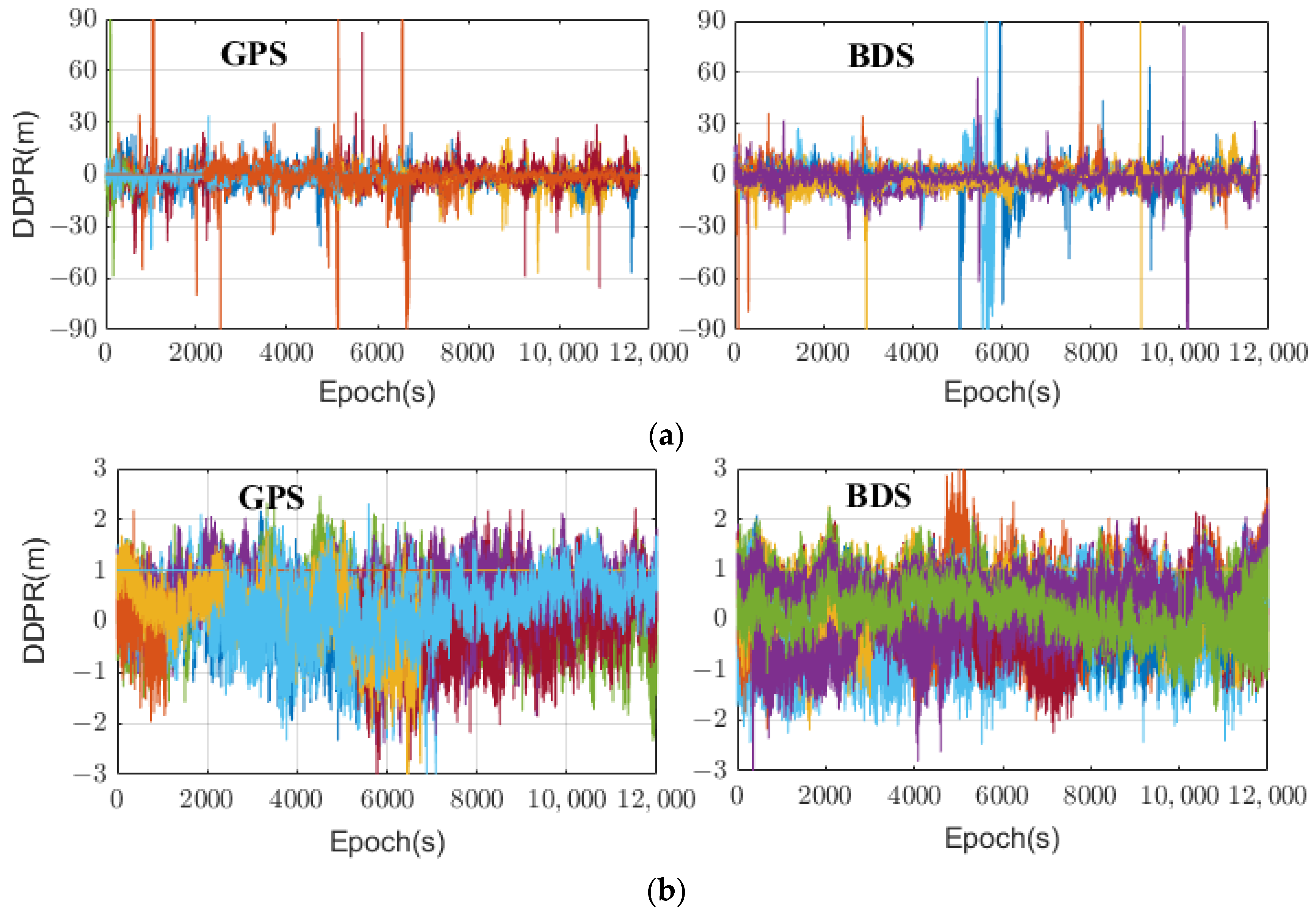


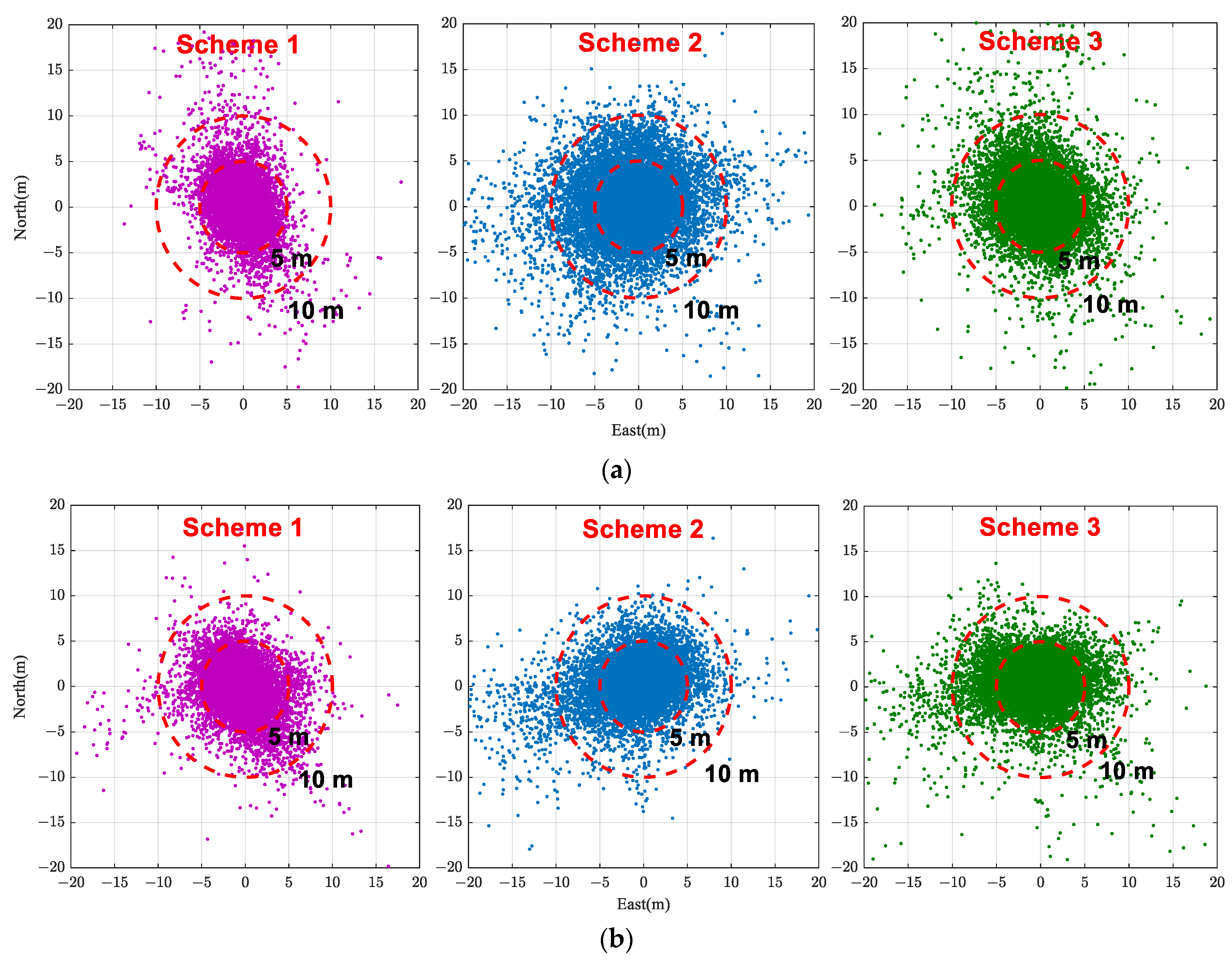
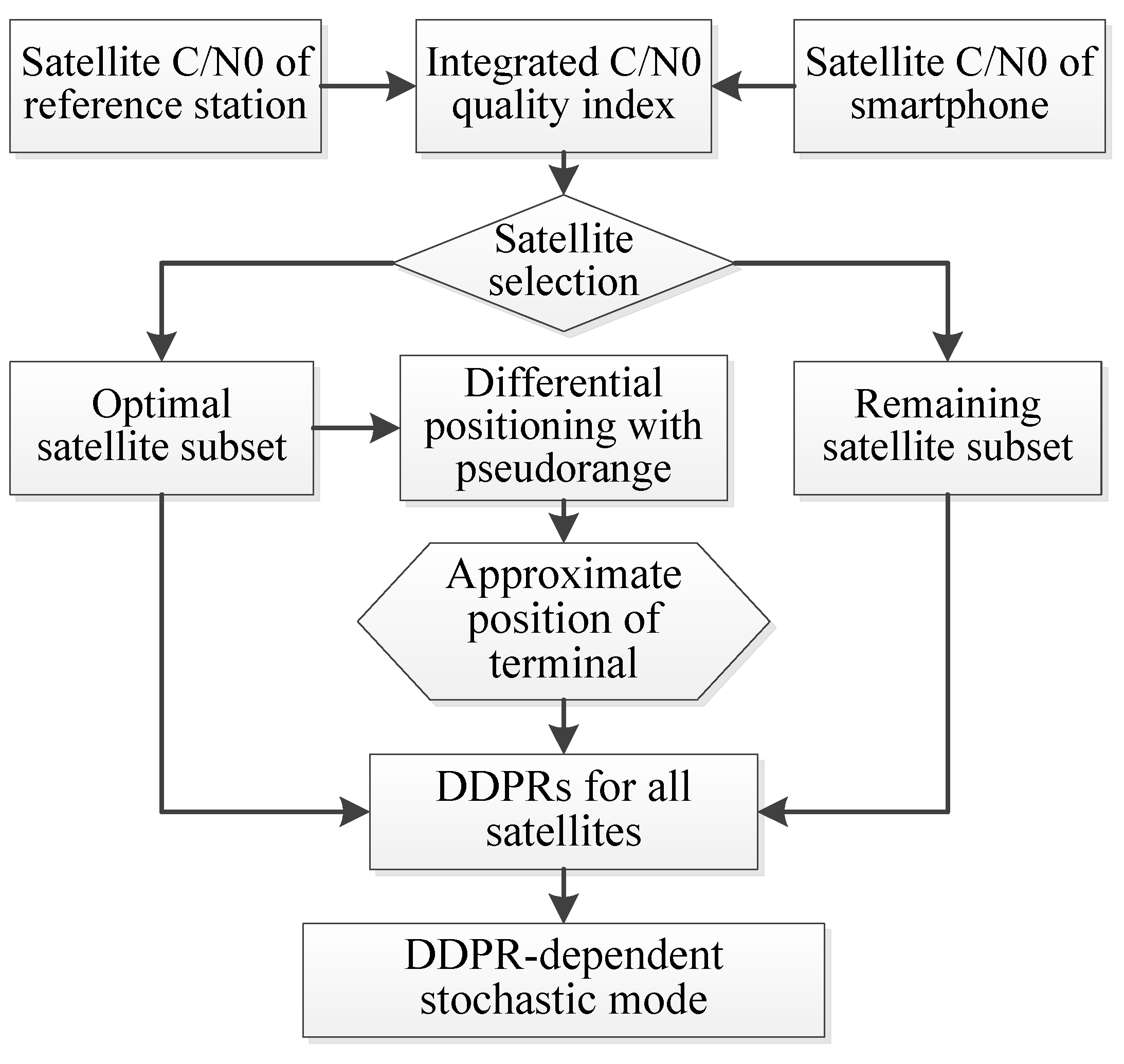
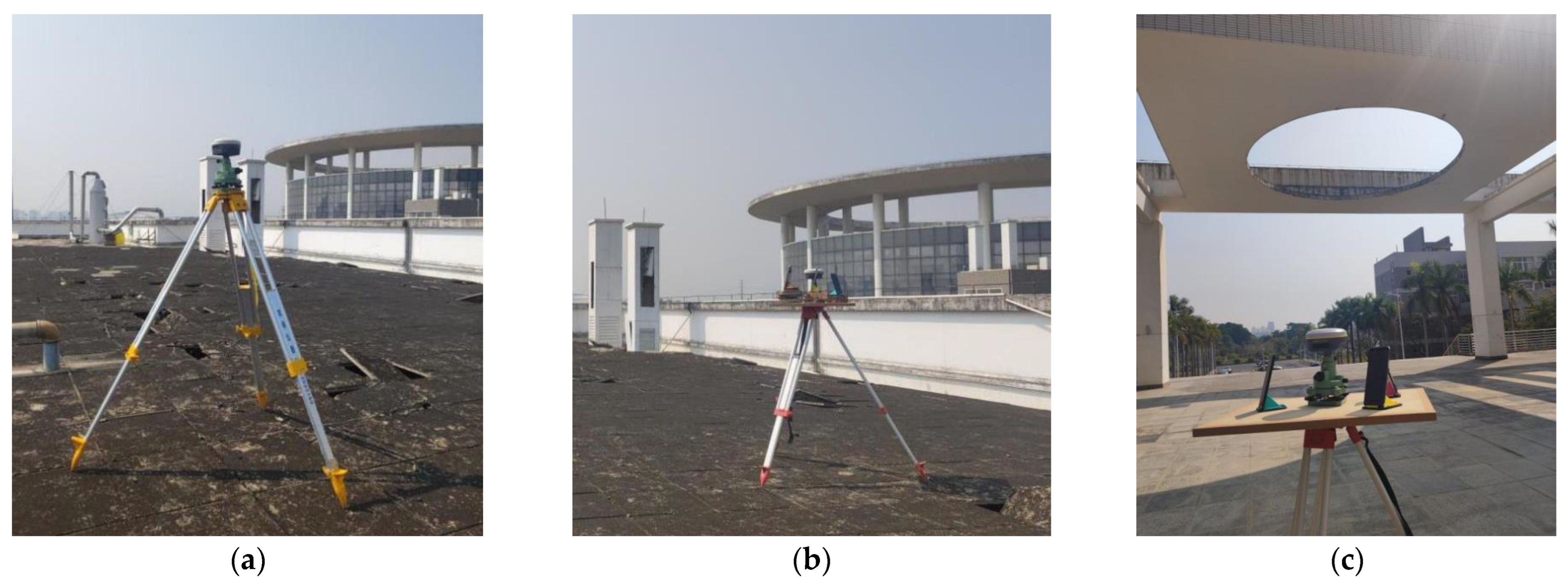

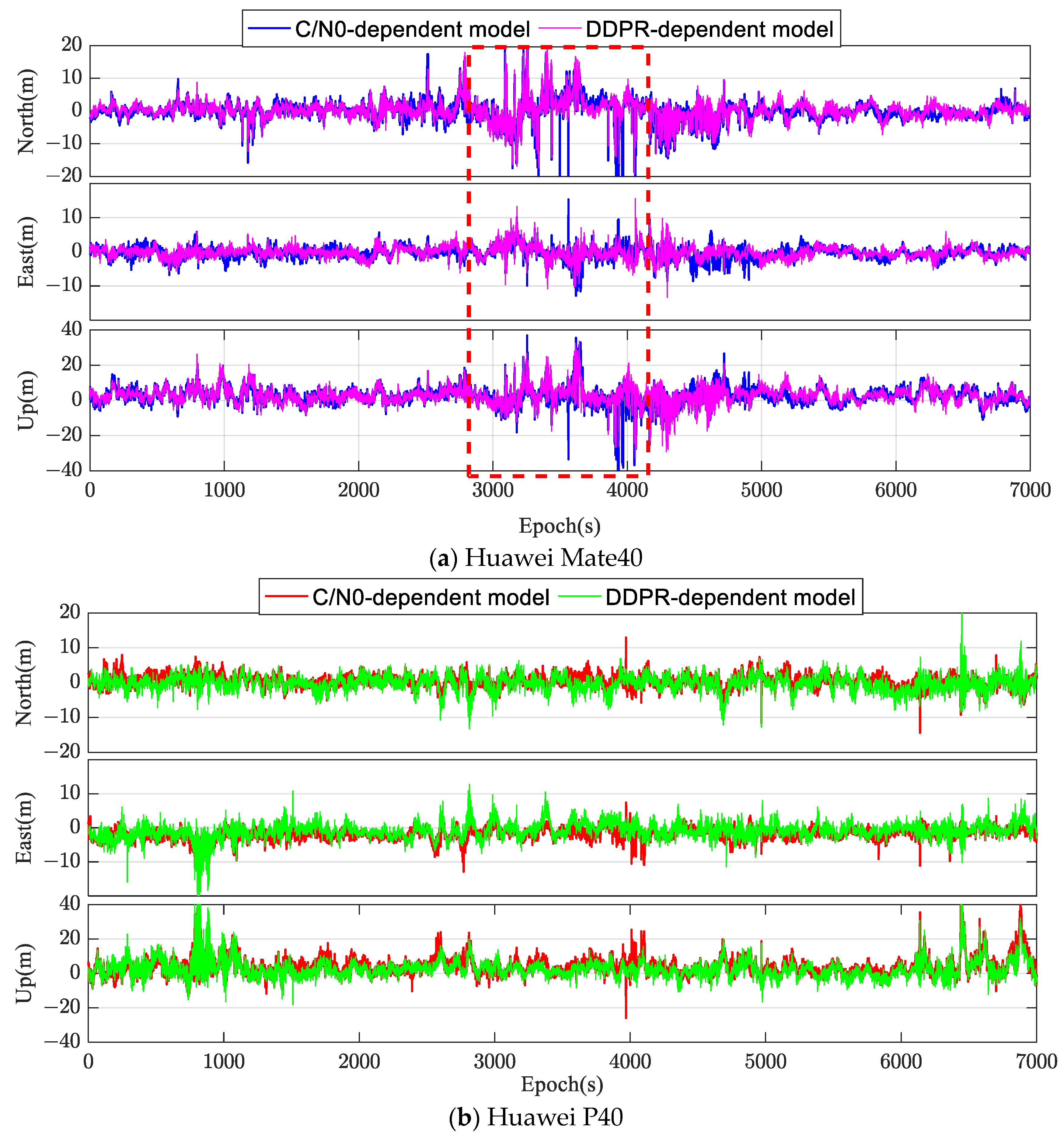
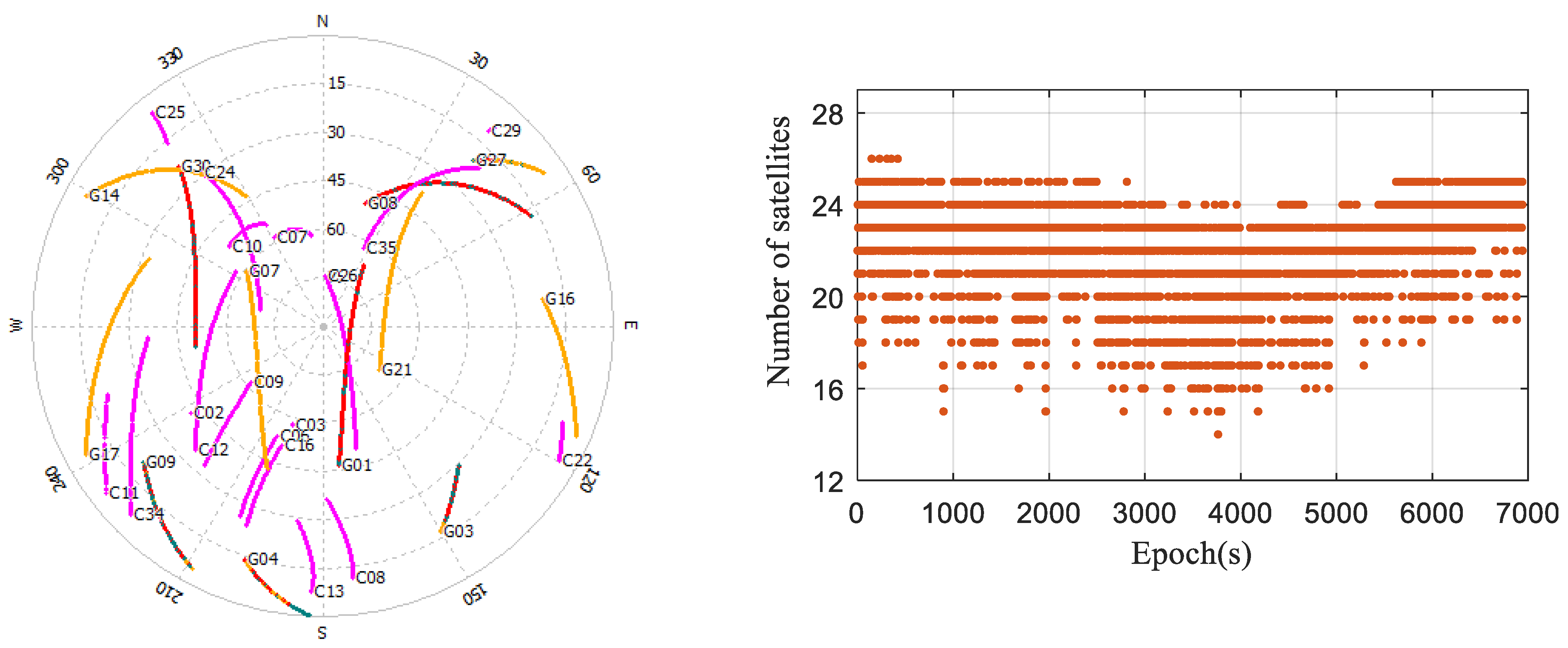
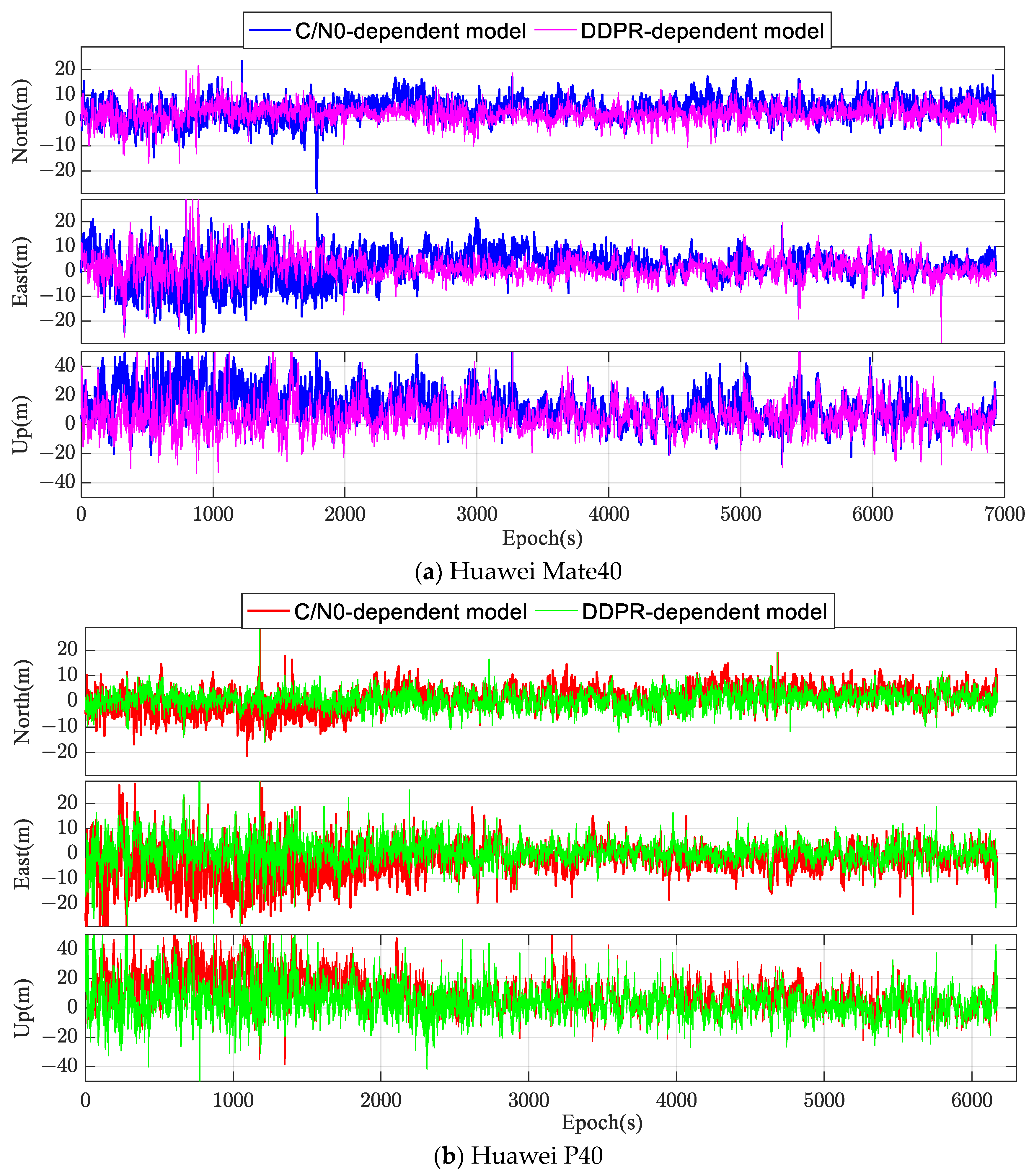

| Selection Scheme | Huawei Mate40 | Huawei P40 | ||||
|---|---|---|---|---|---|---|
| N | E | Horizontal | N | E | Horizontal | |
| Integrated C/N0 | 2.90 | 2.05 | 3.55 | 2.87 | 3.06 | 4.19 |
| Satellite elevation | 3.89 | 4.71 | 6.11 | 2.88 | 4.92 | 5.70 |
| Elevation-C/N0 | 3.71 | 3.29 | 4.96 | 2.88 | 4.58 | 5.41 |
| Device | Direction | C/N0-Dependent (m) | DDPR-Dependent (m) | Accuracy Improvement | C/N0-Dependent (Optimal Subset) (m) |
|---|---|---|---|---|---|
| Mate40 | N | 3.36 | 3.14 | 6% | 3.17 |
| E | 1.93 | 1.80 | 7% | 2.19 | |
| U | 5.85 | 5.72 | 2% | 6.28 | |
| P40 | N | 1.95 | 2.24 | −15% | 2.91 |
| E | 2.58 | 2.56 | 1% | 3.06 | |
| U | 6.61 | 6.12 | 7% | 6.42 |
| Device | Direction | C/N0-Dependent (m) | DDPR-Dependent (m) | Accuracy Improvement | C/N0-Dependent (Optimal Subset) (m) |
|---|---|---|---|---|---|
| Mate40 | N | 6.01 | 4.19 | 30% | 4.25 |
| E | 6.67 | 4.50 | 32% | 4.72 | |
| U | 16.75 | 11.01 | 34% | 12.34 | |
| P40 | N | 4.54 | 3.36 | 26% | 3.68 |
| E | 7.45 | 4.98 | 33% | 5.53 | |
| U | 15.66 | 11.90 | 24% | 14.19 |
Disclaimer/Publisher’s Note: The statements, opinions and data contained in all publications are solely those of the individual author(s) and contributor(s) and not of MDPI and/or the editor(s). MDPI and/or the editor(s) disclaim responsibility for any injury to people or property resulting from any ideas, methods, instructions or products referred to in the content. |
© 2024 by the authors. Licensee MDPI, Basel, Switzerland. This article is an open access article distributed under the terms and conditions of the Creative Commons Attribution (CC BY) license (https://creativecommons.org/licenses/by/4.0/).
Share and Cite
Deng, J.; Wang, H.; Wei, S.; Zhang, A. A Stochastic Model Based on Optimal Satellite Subset Selection Strategy for Smartphone Pseudorange Relative Positioning. Sensors 2024, 24, 2598. https://doi.org/10.3390/s24082598
Deng J, Wang H, Wei S, Zhang A. A Stochastic Model Based on Optimal Satellite Subset Selection Strategy for Smartphone Pseudorange Relative Positioning. Sensors. 2024; 24(8):2598. https://doi.org/10.3390/s24082598
Chicago/Turabian StyleDeng, Jian, Huayin Wang, Shuen Wei, and Aiguo Zhang. 2024. "A Stochastic Model Based on Optimal Satellite Subset Selection Strategy for Smartphone Pseudorange Relative Positioning" Sensors 24, no. 8: 2598. https://doi.org/10.3390/s24082598





